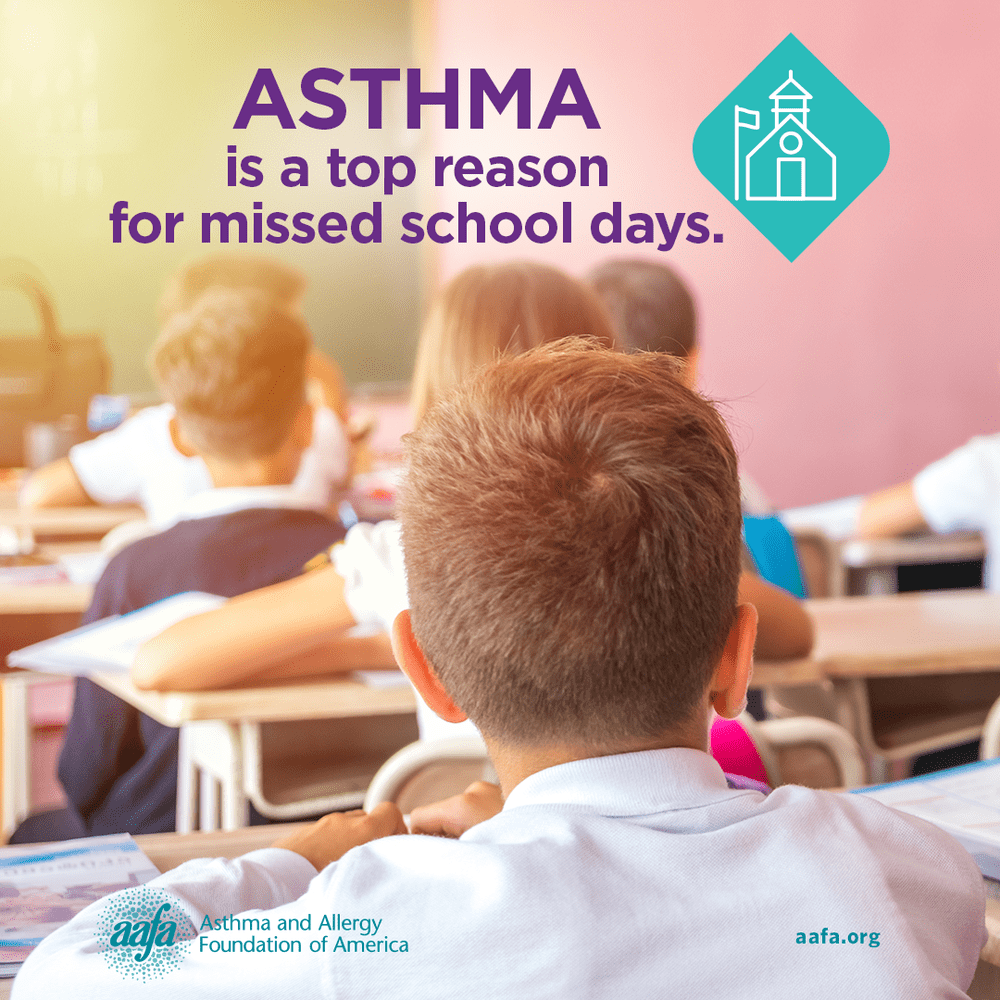Asthma
Asthma in Children
Around 4.5 million children in the United States have asthma. Asthma is one of the most common chronic (long-term) diseases in children. It is also one of the main causes for missed school days.1 It cannot be cured, but it can be managed.
Childhood asthma tends to affect more male children than female children. But adult females have higher rates of asthma than males. Some studies suggest that the increase in testosterone hormone in males decreases swelling in the airways.2
Some children have a higher risk of asthma. Asthma rates are highest in children who are:
- Poor
- Puerto Rican
- Black
- Indigenous, Native American, Alaska Native
- Living in inner cities
- Living near high amounts of air pollution
What Are Symptoms of Asthma in Children?
Most children with asthma will show symptoms before they turn 5 years old.3 However, people can develop asthma at any age. Asthma signs and symptoms in infants and toddlers may also be different from older children and teens.
The signs and symptoms of asthma in a baby or toddler include:
- Fast breathing
- Working harder to breathe
- Nostrils flaring
- Skin is sucking in around and between ribs or above the sternum
- Exaggerated belly movement
- Panting with normal activities such as playing
- Wheezing (a whistling sound)
- Persistent coughing
- Difficulty sucking or eating
- Tiredness, not interested in normal or favorite activities
- Cyanosis, a tissue color change on mucus membranes (tongue, lips, and around the eyes) and fingertips or nail beds – cyanosis appears grayish or whitish on darker skin tones and bluish on lighter skin tones
Signs and symptoms of asthma in school-age children and teens may include some symptoms above as well as:
- Shortness of breath
- Cough
- Chest tightness or pain
- Wheeze (a whistling sound when you breathe)
- Waking at night due to asthma symptoms)
- A drop in their peak flow meter reading (if your child uses one)
September Asthma Epidemic
September is often the worst month for people with asthma, especially children. During this month, there is an increase in asthma attacks, emergency room visits, asthma-related hospital stays, and even deaths. It is called the September Asthma Epidemic.
Several factors can affect people with asthma at the same time during September. Ragweed pollen, the most common fall pollen allergen, peaks in September in the United States. Mold counts go up as leaves collect outside. Children return to school and are exposed to respiratory illnesses, such as the flu, RSV, COVID-19, and colds. Extreme weather events and wildfires can also expose people to asthma and allergy triggers as well.
Many school buildings throughout the U.S. have poor indoor air quality. Many facilities need maintenance and repair, exposing children to asthma and allergy triggers and irritants, such as indoor mold, dust, and pests. Schools may also use harsh, strong-smelling cleaning chemicals, which can also trigger asthma.
Everyone with asthma needs to take extra precautions during September.
- Follow your Asthma Action Plan.
- Talk with your doctor if your asthma is not well-controlled.
- Always carry your quick-relief medicines with you.
- Get vaccines for the flu and COVID-19.
- Take steps to avoid getting sick, such as washing your hands, wearing a mask, not touching your face, and avoiding people who are sick.
- Avoid your asthma and allergy triggers as much as possible.
What Causes Asthma in Children?
Experts don’t know exactly what causes asthma in children. But the following risk factors may make a child more likely to have asthma:
- Family history of asthma
- Respiratory illnesses, such as flu, colds, RSV
- Allergies and eczema (atopic dermatitis)
- A mother who smoked during pregnancy
- Exposure to secondhand and thirdhand tobacco smoke after birth
- Living in an area with high air pollution
Viral upper respiratory infections (URIs) are the most important trigger factor for children with asthma.
How Do Doctors Diagnose and Treat Asthma in Children?
To diagnose asthma in a child, a doctor will ask about medical and family history, do a physical exam, and do lung function tests, if possible. They may also do allergy testing. If your child is too young to do a lung function test, the doctor may prescribe a trial of asthma medicine to see if their symptoms get better.
It is important to get proper treatment for your child’s asthma. This will help them feel better and miss fewer school days. It can also prevent permanent lung damage.
The treatment for asthma in children involves:
- Avoiding or reducing asthma triggers. To do this, you need to know what triggers your child’s asthma and then take steps to manage those triggers. Triggers can include:
- Viral respiratory infections
- Exercise and physical activity
- Cold and dry air
- Big temperature and weather changes
- Allergens (like pet dander, dust mites, pollen)
- Strong odors, irritants, chemicals
- Smoke (wildfire, cooking, cigarette, vaping)
- Medicines
- Indoor and outdoor air pollution
- Strong emotions
Once you know your triggers, you can control or manage them. (Use AAFA’s Healthier Home Checklist to help you.)
- Giving your child their asthma medicines as prescribed. They may need to take medicines daily, as needed, or both. This will depend on the severity of your child’s asthma and the type of medicine they take. Some asthma medicines work to control (or prevent) the inflammation (swelling) in their airways. Other asthma medicines work to “relieve the squeeze” in the airways and aim to stop symptoms after they begin. (Learn more about the different types of asthma medicines and how they work.)
- Following an Asthma Action Plan. It’s important to know the signs and symptoms of asthma and when to give your child their medicines. An asthma action plan can help you manage your child’s asthma. It can also help school nurses, teachers, and babysitters manage asthma in the children they are caring for and know what to do in an asthma emergency. Ask your doctor or health care provider to provide you with an asthma action plan. This plan should be reviewed with your health care provider to make sure it is effective and up to date.
- Taking care of your child’s overall health. One of the top causes of asthma symptoms in children is respiratory infections. All kids get sick and it lets their immune system learn to fight off certain illnesses. But some infections can worsen asthma. Help your child stay healthy by reducing your family’s exposure to illnesses such as RSV, croup, the flu, COVID-19, and bronchitis. You can do this by getting recommended vaccines, good hand washing, and wearing a face mask when these contagious illnesses are spreading in your community.
You can also keep your child healthier by protecting them from exposure to tobacco smoke. If you or a loved one smokes tobacco cigarettes or vapes, there are programs to help you quit. Resources to support your journey to a smoke-free life include:
- Smokefree.gov
- 1-800-QUIT-NOW
- quitSTART app
You can also call your insurance company or your employer to see if they offer tobacco cessation benefits.
Most children with asthma also have allergies. By treating their allergies, it will help their asthma stay under control, too.
When your child’s asthma is under control, you can expect:
- Few or no symptoms
- No interruptions to their daily activities (school, play, exercise) or sleep
- The ability to take part in sports and physical activity
- Fewer missed school days
- Prevention of acute asthma attacks
- Decreased need for quick-relief medicines
- Improved overall quality of life

Can My Child Outgrow Asthma?
Asthma is a life-long disease with no cure. As a child gets older, their asthma symptoms may get better and appear to “go away.” But airway inflammation may never truly go away. It often returns later in life. About half of children who had asthma will get symptoms again when they are in their 30s or 40s. They may also develop new asthma triggers over time that could cause symptoms to reappear.
Medical Review: June 2022 by John James, MD
Closed
References
2. Fuseini, H., & Newcomb, D. C. (2017). Mechanisms Driving Gender Differences in Asthma. Current Allergy and Asthma Reports, 17(3). https://doi.org/10.1007/s11882-017-0686-1
3. Asthma in Children: Signs, Symptoms and Treatment. (n.d.). American College of Allergy, Asthma & Immunology. Retrieved June 28, 2022, from https://acaai.org/asthma/asthma-101/who-gets-asthma/children











